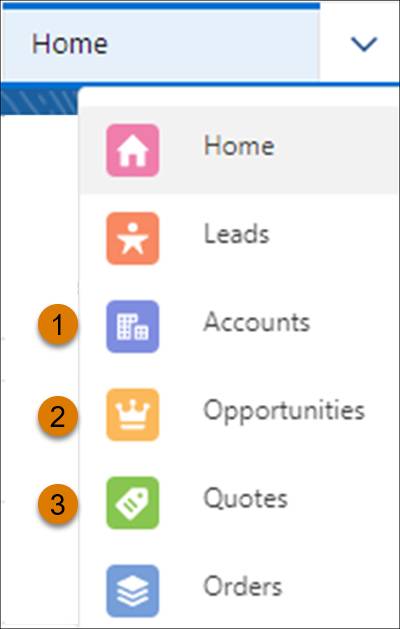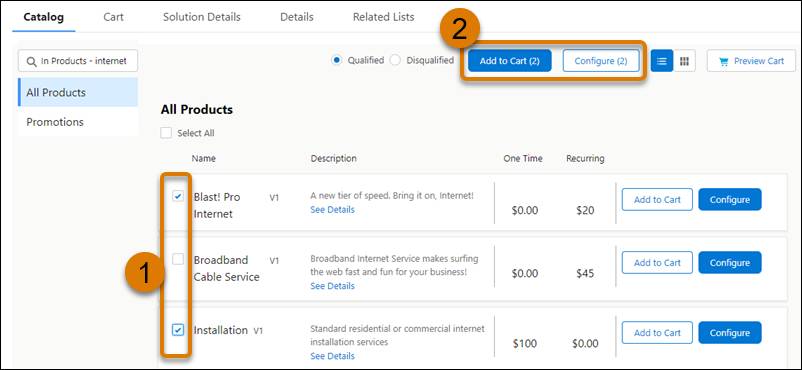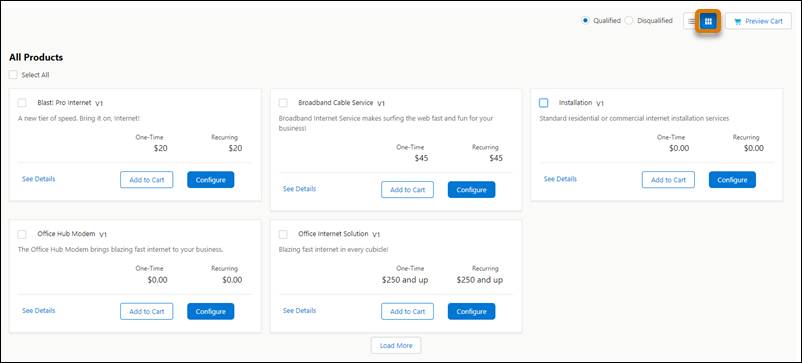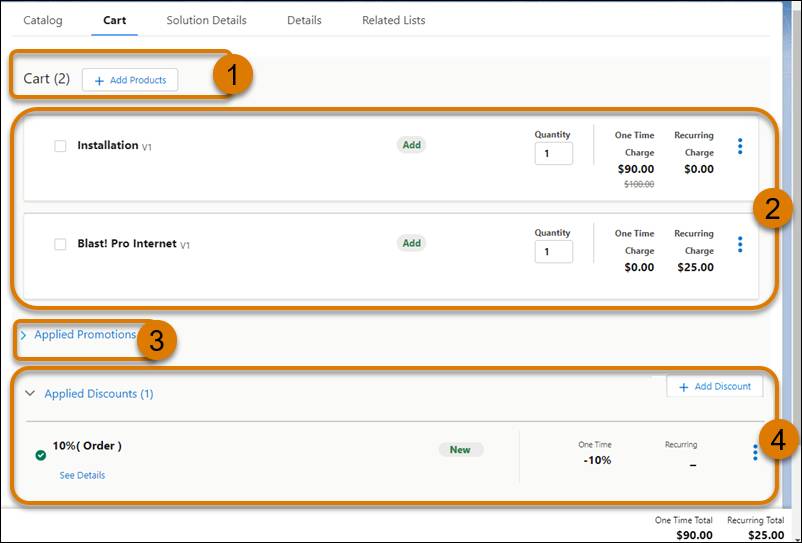Add Products to the Cart
Learning Objectives
After completing this unit, you’ll be able to:
- Locate existing quotes.
- Browse and search the catalog.
- Explain the purpose of product versioning.
- Add products to the cart.
- Review the cart contents.
Quote Access
You’ve been working on a large quote for your favorite business customer, Acme, to configure a best-fit solution for their office upgrade. If you close this deal, you’ll hit your Q2 sales target, so you don’t want to lose this big fish!
Sai Grover, your Acme contact, calls you and says he’d like to add three Infiwave phone handsets to the solution.
First, you need to find the Acme quote so you can update it. You can do this in several ways. Choose any of the Accounts, Opportunities, or Quotes options in the navigation tab, as shown here.

- From the Accounts list, locate the Acme account, find the opportunity, and then open the quote from the list of associated quotes.
- From the Opportunities list, find the opportunity, and then open the quote from the list of quotes.
- From the Quotes list, find and open the quote.
Thank goodness for shortcuts. You were super-efficient to bookmark the quote in your browser earlier. You click the bookmark to open the quote. Once the quote is open, use two tabs to add and configure products: the Catalog and the Cart.
The Catalog
Think about the last time you went to your favorite online clothes store to buy a new shirt. You clicked the Tops category and browsed through all the different T-shirts and shirts available before selecting a shirt you liked. Then you chose the color and size before adding it to the cart.
The Catalog tab in Industries CPQ quotes and orders provides the same functionality. You browse items by category or search for them. Once you find a product or promotion you like, you select it, configure it, and add it to the cart.
Here’s an example of a catalog workspace on a quote in the training playground.

Browse Product Categories
Click the category you want to view in the browse pane (1). The training playground has two categories: Products or Promotions. However, in your organization, you might have a category for each of your product families. Think of Accessories and Shirts categories in your favorite online store. Rules and filters built into Industries CPQ ensure your customer sees only those products and promotions that are deliverable and suitable for their requirements.
Search for Products or Promotions
To search for a product or promotion, type part of the name or description in the search bar at the top of the browse pane (1). In the example above, the user searches for all products that contain the word internet in the name or description.
The results list (2) shows products and promotions filtered by the search input and by predefined rules set up in the catalog. Each result includes the product or promotion name, version, description, and pricing. The results list in this example is a context-filtered list of all the products in the catalog that contain the word internet in their name or description. To find out more about the product, click See Details.
Select and Configure a Product or Promotion
You’ve found the item you want to add to the cart. From the results list in the catalog, click:
-
Add to Cart to add the product or promotion to the cart. Then click the Cart tab to go to the cart workspace and configure it to suit your customer’s requirements.
-
Configure to configure the product or promotion before adding it to the cart.
What if you want to add multiple products or promotions to the cart at the same time?

Click the checkbox for each product or promotion you want to add (1), and then click Add to Cart (2). You can also click Configure (2) to configure each item before adding it to the cart.
Change List and Tile Views
You’re viewing the results list in List View. This is useful when you want to view many products or promotions at the same time.
 Click Tile View to see product information in tile format. Tile view displays more information about each item in the results list.
Click Tile View to see product information in tile format. Tile view displays more information about each item in the results list.

Product tiles are customizable and may include product images, document links, and other information to help you choose products.
Preview the Cart
To the right of the Tile View button, notice the Preview Cart button. Click it to add the cart preview to your catalog workspace, as shown here.

The Cart Preview appears on the right with a summary of what’s included in the quote cart so far. When you’ve finished with the preview, click Close.
The Cart
Click the Cart tab to view or change items in your quote.

The Cart Header (1) displays the count of offers in the cart. Click + Add Products to open a catalog pane. This is where you can browse, configure, and add products to the cart, just as you do from the Catalog workspace in the quote.
The Cart Product List (2) shows details about the products and promotions added to the cart. If the cart has a bundle of products, you see a forward arrow (>) to the left of the name. Click the arrow to expand the bundle so you can see all its components.
Click Applied Promotions (3) to see any promotions applied to the cart.
Click Applied Discounts (4) to view any discounts applied to the quote. To add a custom discount, click +Add Discount.
Quote and Order Line Items
Items in the cart product list are called quote line items or order line items if part of an order. Here’s an example of two quote line items in the cart: Broadband Cable Service and Office Hub Modem.

If you’re amending multiple items at once, use the checkboxes to the left of the quote line item names to select the items. Let’s see what else is displayed for each item.
Product Version
Notice how a small V1 follows each product name in the example? This is because your training playground has versioning set up. Versioning is optional, but it’s a useful feature of Industries CPQ, particularly when you’re working on a quote over a long time.
Versioning gives you the flexibility to sell a product with the features or pricing that were present when you added the product to your cart or to update the product to the latest version.
The Acme Quote
Let’s revisit our scenario. Sophia’s team has been working on the Acme quote for a while. The first product, Broadband Cable Service (version 1), was added to the quote a month ago. Last week, Infiwave released a new version of the Broadband Cable Service (version 2). It includes free installation and some new features and costs an additional $2 a month.
You discuss the new features with Sai from Acme, and he’s all in. So you open the quote, remove version 1 of the Broadband Cable Service and add version 2 from the catalog. This way, Acme receives the benefits of the new release.
Order Action
To the right of the version number is an action tag: Add. This tells you what will happen to the customer assets when processing the quote as an order. Here, the Office Hub Modem and Broadband Cable Service will be added to Acme’s assets. However, if the purpose of the quote was to change or delete existing assets, the tag might read Existing (no change is made) or Cancel.
Quantity
This is the quantity of the product added to the cart. You can amend this amount to suit the customer. You may find that you see an Alert when you change the quantity, or the quantities may be set automatically so you can’t change them. Don’t worry! This is because one or more of the products in the cart contain cardinality rules.
Cardinality rules control the number of a certain product allowed for the customer. The basis for these rules may be the context of the customer, the products they already own, or the products that they’ve added to the cart. It’s just another way to make sure the orders you place are accurate and deliverable to your customer.
Charges
For each product or promotion in the cart, you see two prices.
-
One Time Charge is a single, nonrecurring charge. An installation fee or an equipment purchase are examples of one time charges.
-
Recurring Charge is a regular ongoing charge, such as a monthly service fee.
In this example, the Office Home Modem one-time charge is reduced for this customer, with the original price struck out beneath the new amended price. This is because a discount is applied.
Line Item Actions
Each line item in the cart has an associated action menu. To access the actions, click the More [፧] menu at the end of each line item.

The available actions change depending on the status of the quote and the line item. Examples of actions include:
-
Adjust price, to reduce the price by a percentage or amount
-
Clone, to add a copy of the current line item with all its associated configurations to the quote
-
Configure, to set the attributes of the line item to suit the customer
-
Delete, to remove the line item from the quote
Now that you've seen how to add products to a quote, let’s continue to the next unit to learn how to configure and amend
quote line items.
Resources
- Salesforce Help: Search for Products and Promotions
- Salesforce Help: Child Line Items in the Cart in LWC
- Salesforce Help: Delete a Line Item from the Cart in LWC
